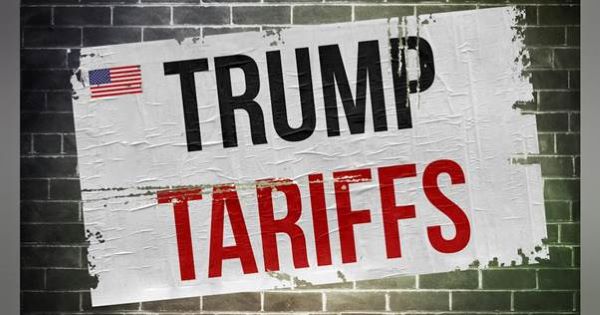Trumped-Up Tariffs
We have been here before during Trump's first term when single malts were caught in the cross-fire of the aircraft subsidies dispute and hit with 25% tariffs. This time it's only 10% and across the board for all imports. Tom Bruce-Gardyne assesses the likely damage …
"It is so important that we have tariff-free trade across the Atlantic," declared Graeme Littlejohn, strategy and communications director at the Scotch Whisky Association, standing in front of the White House last May. He added that once the US and UK elections were out the way, "we need to make this the top transatlantic trade priority and remove Scotch whisky from harm."
Littlejohn and his colleagues were in Washington to lobby Congress not to resume the crippling 25% tariff on single malt Scotch that lasted 18 months and cost the industry at least £600 million. It was introduced by Trump in his first term as part of the long-running and totally unconnected dispute between Airbus and Boeing, and it was suspended by Joe Biden in June 2021 for five years.
Tariff-free trade feels like a distant dream right now. Nobody knows whether the current 10% levy on UK exports will evaporate in some 'beautiful' trade deal with America, or whether that 25% malt tariff will return next summer, and the two be added together. Chances are, Trump will keep everyone guessing until the last minute.
Before his 'liberation day' tariffs on April 2nd, the industry had been braced for a 20% hike and many distillers shipped early. In its Q3 results (Jan-March) Pernod Ricard's overall net sales were up 2% in the US as a result of wholesalers ordering ahead of tariffs, although it remains 5% down in the year to date (July-March). The company reported that the US spirits market remains broadly stable.
The latest release from the IWSR on the likely effect of all this on the US market stated that: "Scotch and Irish whiskies are heavily exposed to the premium price tier that has already come under significant pressure from the impact of inflation on consumer purchasing power, and which stands to lose the most to downtrading."
That was on March 4th when the two categories set to suffer most were Canadian whisky and Tequila, then on 25% tariffs. The EU was facing similar punishment being, in Tump's words: "one of the most hostile and abusive taxing and tariffing authorities in the world, which was formed for the sole purpose of taking advantage of the United States."
This month it is 10% for everyone bar the Chinese. Next month who knows? "There's frustration over the stop-and-start nature of tariff announcements, which makes it nearly impossible to plan," says Michael Bilello, the executive vice president of strategic communications for the Wine and Spirits Wholesalers of America.
How much to absorb or pass on to the end consumer is a decision for every brand owner. During the 25% tariffs of 2020/21, The Glenlivet, America's top-selling single malt, swallowed much of the increase and grew sales and market share as a result.
"I think at 10% it's not going to damage the market too much," says Leonard Russell, MD of Ian Macleod Distillers, who appreciates that it is "a level playing field" when it comes to rival imported spirits. "The three-tier structure in America makes it preposterously expensive anyway because importers and distributors take a margin along the way, so I don't know how that's going to translate into a retail price. Maybe the tariffs won't filter through to the consumer so much if the rest of the trade compromise to keep the business."
It is unclear what impact tariffs will have on US inflation, and thus disposable incomes. Leonard fears that given the level of stocks in the market, the industry might indulge in a bit of a price war, "especially when consumers are already trading down." And yet, he insists that: "Americans still have a penchant for premium whisky," and points to his own Isle of Skye blend which "is doing really well in the States, and is doing really well as a 21 year-old."
Diageo's Johnnie Walker has always been a good barometer of US spending power, and it will be interesting to track how many drinkers this year trade out of Black Label, currently around US$25-26, to Red Label and save themselves US$6-7 in the process. At least it keeps them in the fold. Any Chivas Regal drinker, priced out by inflation, has to switch to say Ballantine's to stay loyal to Scotch and brand owner Pernod-Ricard.
Unfortunately, Scotch whisky's woes in America run deeper than tariffs. The sales data for 2024 compiled by the Distilled Spirits Council of the US makes for a sobering read. The drink was the worst-performing category, with volumes down 13.6% for blends and 16.8% for single malts. In terms of value, blends tumbled 15% while malts fell 14.1%.
By comparison, American whiskey dropped 1.8% by value, Irish whiskey grew 1.8%, Tequila was up 2.9%, while pre-mixed cocktails and spirits-based RTDs soared by 16.5%. Within this last category which is becoming steadily more premium, Scotch whisky is strangely absent.
At least there is the rest of the world to consider, starting with America's northern neighbour. As Leonard Russell says: "There must be further opportunities for Scotch in Canada where people won't be drinking so much Bourbon."

Award-winning drinks columnist and author Tom Bruce-Gardyne began his career in the wine trade, managing exports for a major Sicilian producer. Now freelance for 20 years, Tom has been a weekly columnist for The Herald and his books include The Scotch Whisky Book and most recently Scotch Whisky Treasures.
You can read more comment and analysis on the Scotch whisky industry by clicking on Whisky News.




